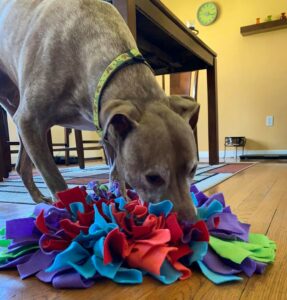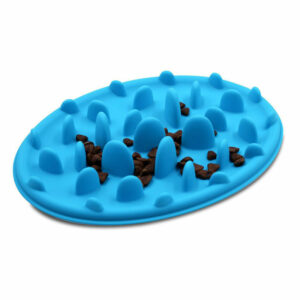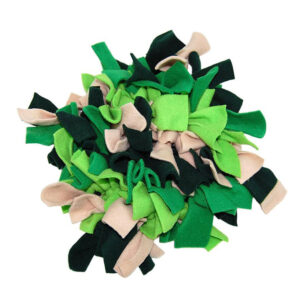Barks Blog
Feeding Time Frenzy!
By Robyn Lowe

As a vet nurse, I see animals on a daily basis struggling with osteoarthritis. Some owners know about it and are well on the way to tackling it, some are innocently oblivious, and some in denial! Wherever on this scale you sit, having your dog diagnosed with osteoarthritis may have come as a bit of a blow, things are going to have to change for both you and your dog.
A common worry is that your dog is going to suffer greatly from boredom – you’re getting told no long walks, no ball throwing, no rough play, no uneven terrain… what are you supposed to do then? Well I’m here to give you some ideas and pointers on how to keep your arthritic dogs active (in mind and body), even during the bad days.
Today I’m focusing on feeding time but this is obviously only one part of a whole host of things that come into play as part of a multimodal approach to managing your dog’s arthritis!
How long does it take for your dog to finish his breakfast, dinner, and tea? 15 minutes? 5 minutes… 5 seconds??? Let’s face it, some dogs literally INHALE their dinner. Then they spend the next few hours waiting for the next feed! If you have a dog like a vacuum these ideas are for YOU!
It has been documented in humans that moderate exercise improves arthritic pain, so making meal time physically and mentally challenging is of great importance and benefit.

Feeding from a slow feeder is one way to do this. As slow feeders are plastic you can include dry, or wet foods (if the slow feeder manufacturers recommend it), and even include their medications or supplements into the mix – just make sure to check they’ve taken them and not left them behind! Also make sure it’s cleaned thoroughly daily and use it at EVERY meal time.

Another option (for dry food and treats only) is a snuffle mat, one of my favourite items. It is gentle on the nose, simulates natural foraging behaviour, increases mobility and prolongs meal time too! I especially like the snuffle mat for dogs with elbow and neck pain, as it can easily be placed on a foot stool or raised box to offload pressure and avoid your dog having to stretch downwards for too long, just another way to make things just a little more comfortable for your dog.
If feeding a dry food, you can even scatter feed – simply throw the kibble across your floor and let them hunt it down!
Here are some final pointers for greedy/overweight dogs:
- Take your dog to be checked over by a veterinary nurse and have them carry out a body condition score – a great way to identify if your dog is healthy weight. If overweight then it must be tackled ASAP, a reduction of 6-8% has been shown to improve pain scores in dogs with arthritis!
- Mix it up daily – use different methods of feeding at every meal time, scatter, hide, snuffle and slow feed. This way your dog is getting stimulated mentally and physically multiple times a day.
- Use food from your dogs daily portion for treats and for retrieval, hiding and sniffing games, this way they are having fun but aren’t going to pile on the pounds because of extra treats.
- Always measure out your dogs food using digital scales – it has been shown that a scoop or measuring cup can lead to under or over feeding by as much as 20% at each meal!
- If your pet is overweight then attend veterinary weight clinics with a competent RVN – they will help with pointers and keep you on track, like doggy weight watchers!
For more information visit Canine Arthritis Management:
https://caninearthritis.co.uk/managing-arthritis/diet-and-nutrition/
https://caninearthritis.co.uk/managing-arthritis/weight-management/
About the Author
Robyn Lowe of PPG corporate partner Canine Arthritis Management is a Registered Veterinary Nurse who qualified with a degree from Myerscough School of Veterinary Nursing in Preston, England, in 2016 and started her RCVS Diploma in Advanced Veterinary Nursing in 2018. She has worked on a volunteer basis with animals since she was four and her passion for the profession has only grown since then. She spent years of her life at the Horse and Pony Protection Association (HAPPA) and later at a local rescue and rehabilitation yard. Here she met a veterinary surgeon who inspired her, and went for her first work experience in 2008 at their busy mixed practice. She has also travelled to Thailand to volunteer her knowledge and skills working with elephants, horses, goats, pigs, water buffalo, cats and dogs. She loves osteoarthritis clinics and using multimodal approaches to managing the condition, stating that it can be extremely rewarding seeing both owners and patients travel this extremely difficult journey together to improve quality of life for their pet.

